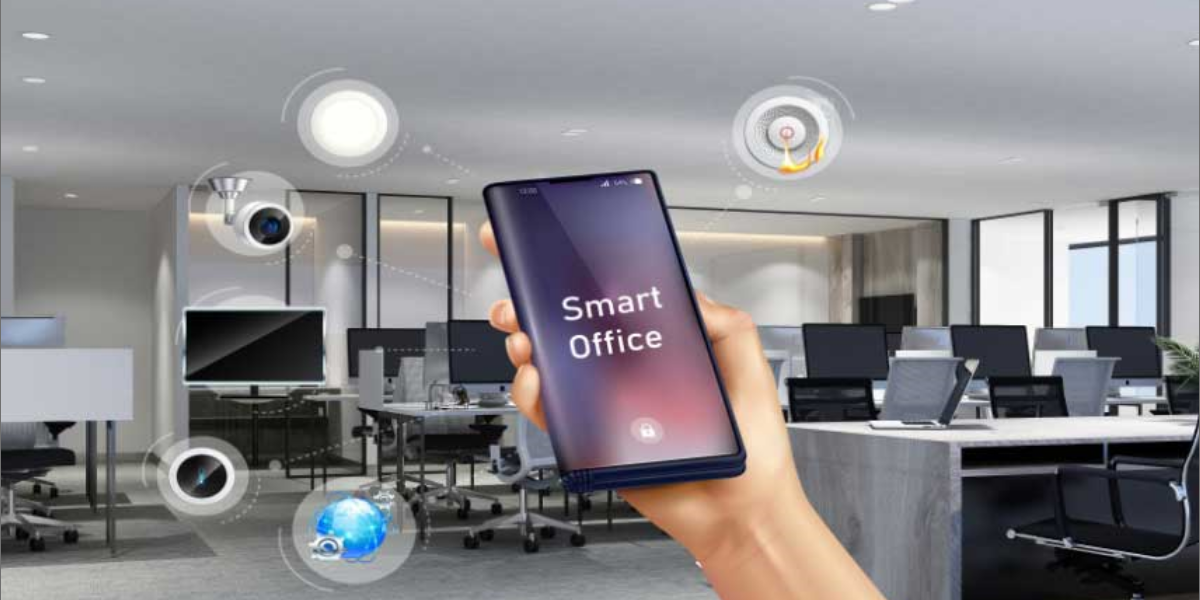While most people devote around 8-10 hours a day at the office, it is only expected that developing automation using IoT is a growing force. As per the latest report, the area of the smart office market is regularly growing. It was $22.21 billion in 2017 and is predicted to double by 2023, reaching $46.11 billion.
There are genuine ideas for the selection of smart office technologies. With the Internet of Things in workplace buildings, you can boost workplace productivity, streamline routine jobs, and make reliable and more convenient working surroundings for your employees.
What are the other advantages of smart office solutions, and how do you develop one yourself? Here are some insights into IoT Development.
What is IoT-based Smart Office Automation?
IoT technology for a smart office suggests several devices in an office connected to the IoT, letting remote control of them. These devices work and manage data without human communication. With smart technology, offices can be more effective than ever earlier, allowing the automation of everyday jobs to have more time to work on significant projects. There are various methods to take advantage of smart office technology.
Energy Consumption
A timer helps several machines run more efficiently. Businesses placed processes and machines on a timeline to get a better understanding of how many resources they need. When people approach a certain location, they turn on, and when they exit, they turn off. LED lighting is used in many smart workplaces, with lights embedded in the flooring or along the walls to aid users to stay spaced a specified safe distance apart.
Tracking energy use helps a company to see what scheduling or other improvements will help them save money every month. For example, scheduling people a half-hour later in the morning and evening to save on heating costs may dramatically reduce total energy usage.
Monitoring Office Climate is Easier than Ever
Smart IoT thermostats are one of the first IoT inventions to gain traction, but sophisticated smart offices go far beyond what is available in smart homes. Temperature, carbon dioxide (CO2), and humidity can all be measured and regulated using IoT technology. A building or operations manager may use this power to construct the ideal working atmosphere for each employee. It is possible to install a device that controls the blinds automatically, reducing the need for heating and cooling.
One of the simplest and most cost-effective ways to incorporate IoT smart workplace automation is to use smart technology for climate management. Air conditioning and heating are operated remotely and can be adjusted according to the time of day. Businesses may take things a step further to have the temperature system automatically switch on or off based on how many people are in the building.
Let’s see a typical case:
Consider an employee who is seated by a window. Smart blinds detect when the sun shines directly on their faces and immediately lower. The blinds may be adjusted at a certain time of day or after the monitoring device collects sensor data showing that they need to be adjusted.
Smart Furniture Improves Productivity
Smart office furniture, such as desks, tables, and even separating walls, will help workers be more productive and happier. Having the power of their desks, for example, allows them to set targets for how often they want to go from sitting to standing.
Employees may have their workspace height automatically adjusted, or they can opt to collect details about their actions during the day or week.
Smart mirrors, which can be used in bathrooms and other areas of the workplace, display relevant information and play videos. Smart mirrors in meeting rooms, lobbies, and entryways allow for successful displays. Smart mirrors are popular with clients and visitors. Using them allows a company to make a good first impression.
Smart Office Security Solutions Save Companies Money

IoT-based smart workplace surveillance systems go beyond just monitoring cameras remotely. They can say who has entered a house, where a person is, and how many people are in the office using voice and face recognition. This helps businesses to keep track of how close they are to reaching potential while still ensuring that no unauthorized individuals are present in protected environments.
Since they can use advanced systems to keep track of who is coming in and out of the house, security automation can also save costs on security personnel. For real incidents, the security automation generates reports and sends warnings. When the last employee leaves the workplace for the day, a message will be sent to ensure that the monitoring system is turned on.
The machine generates notes instantly on who was in an office, providing businesses more information about how to optimize traffic in a building and who could be involved in security breaches.
The placement of trackers on high-value objects is another smart technology approach that eliminates the risk of physical theft. With the option to get alerts anytime an item is relocated or exceeds a certain level, this can be a major advantage in certain companies.
Smart Scheduling for a Post-COVID Office
In a post-COVID workplace, scheduling is crucial. IoT technology makes it much easier to maintain an optimal staffing level during the day to ensure that safety procedures are followed. Companies should implement a check-in procedure to keep an eye on any possible red flags. Companies will use this app to keep track of who was in the same space as them and where they parked their vehicles using smart parking solutions.
Smart scheduling will reduce overtime and stagger start and leave hours, allowing employees to have more flexibility in their schedules while reducing the number of people in the same region to a minimum. Smart scheduling will generate a master schedule that takes into account the interests of all employees while still meeting the company’s overall needs.
In a post-COVID office world, smart scheduling for IoT-enabled devices and networks is beneficial. Companies may create schedules for IoT products that are required to match employee schedules automatically. This is useful if workers phone in sick so their workspaces will instantly change if they are not there.
One of the strongest applications of smart workplace systems is making real-time improvements to IoT schedules.
Smart Inventory Keeps Companies Operating Smoothly
One of the most time-saving IoT integrations that businesses can implement is smart inventory. Instead of manually counting product items and editing an old excel or paper document every week or month, smart offices monitor inventory with Radio Frequency Identification (RFID) Tags. This clever approach provides a more accurate inventory asset assessment.
RFID tags will assess the period and exact position of the last scan of each mark, allowing IoT technologies to monitor not just the total amount of product, but also the time and exact location of the last scan of each label. Businesses now have a clearer understanding of how a product is counted, transferred, and used. It’s easier to spot issues like manufacturing bottlenecks, staff theft, and order issues with real-time usage data.
Smart inventory will produce reports that display the best amount of goods to order based on the lead time, ensuring that businesses are still ahead of customer demand. The more an organization uses RFID technologies to monitor inventory, the more reliable it becomes, and the more effective it becomes.
Companies should mount trackers to products with a high risk of failure or theft, in addition to RFID technologies, to see if they can make their travel through the manufacturing chain more safe and effective. For IoT solutions with a huge inventory, this technology is advantageous. Physical stock positioning may have a significant impact on market performance.
Security Solutions
The most popular IoT solutions in offices are security cameras, smart locks, and various sensors.
You may also replace traditional badges with digital badges to replace the old pass scheme. To clock in or out, all you need is a mobile with the software enabled. The same can be said about access control and visitor management.
Final Lines
Despite its many benefits and existing applications, smart office technology has generated some skepticism among potential customers. Many company owners are also reluctant to engage in IoT solutions in the workplace, although those who have used a variety of items have mixed feelings.
Having an IoT-enabled office, though, entails far more than being able to control the temperature or illumination from a smartphone. It translates to smoother, more productive processes and, as a result, a higher return on investment.
It is entirely up to you whether or not to incorporate these solutions in your workplace. However, bear in mind that even a small improvement in your company’s productivity will give you a significant competitive edge over the market, not to mention that a pleasant workplace will help you recruit and retain top talent.



